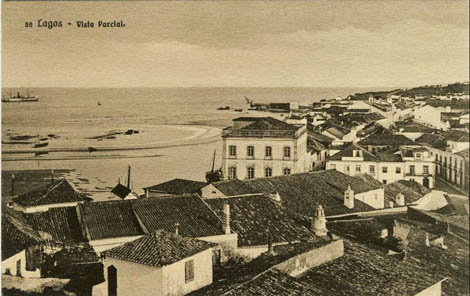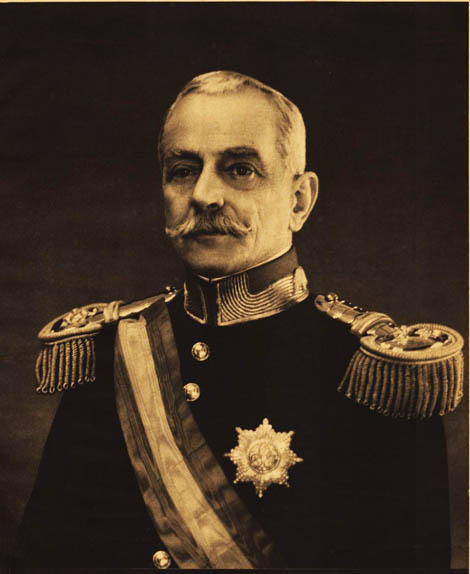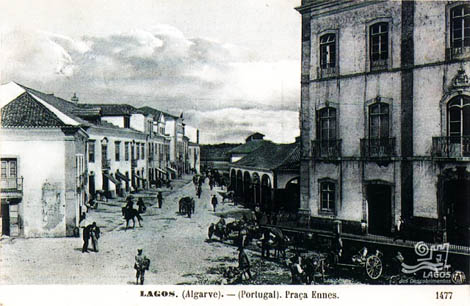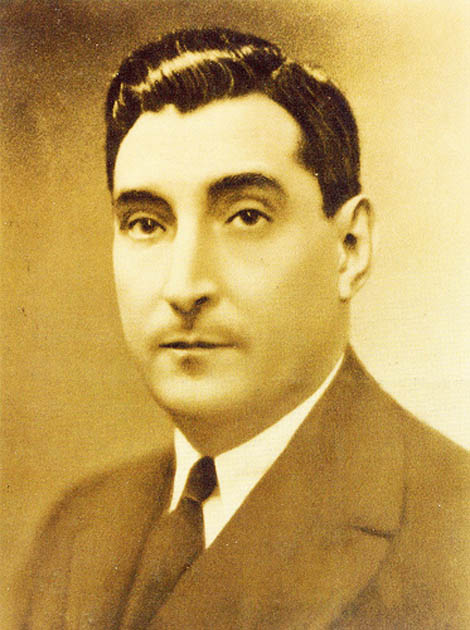 In 1932, President Óscar Carmona's tour of the Algarve was a long one, almost from one end to the other. It was the second visit by a head of state to the Algarve after the establishment of the Republic. The X chapter of this trip is dedicated to the visit of the Head of State to Lagos, where he heard about the greatest local aspiration: the construction of a port.
In 1932, President Óscar Carmona's tour of the Algarve was a long one, almost from one end to the other. It was the second visit by a head of state to the Algarve after the establishment of the Republic. The X chapter of this trip is dedicated to the visit of the Head of State to Lagos, where he heard about the greatest local aspiration: the construction of a port.
The fourth and last day of the presidential visit to the Algarve, February 18, 1932, took the head of State and other delegations (president of the Ministry, ministers of Commerce, Navy, War and Justice, civil governor, etc.) to visit Lagos and Sagres.
The city of Discoveries was not completely unknown to Óscar Carmona, as he had commanded there, in 1925, for a few months, the 4th Military Region.
The distinguished visitors left Praia da Rocha at 9:00 am, where they stayed after visiting Portimão the day before.
Despite the rain that was pouring down copiously, the motorcade was greeted in different places by masses of people, who enthusiastically cheered the visitors, throwing flowers at them.
An hour later the presidential entourage entered Lagos. The reception in the city was described in a sublime way by the journalist from “O Século”: “In Lagos the reception was grand, despite the picturesque nature of the rain. Thousands of people, under umbrellas, pressed together in the streets and, especially, in the square in front of the Paços do Concelho, releasing vibrant "lives" all the time. The windows were crammed with ladies who were pouring veritable floods of flowers on the cars. Rockets crackled, mortars rumbled, flags swamped on top of masts.'

As in other places in the Algarve, the welcome session took place at the Town Hall. Abroad, the honors rendered by the honor guard (15 Infantry Company) took place, and after the national anthem, the head of state and ministers went up, under a thick carpet of flowers, the stairs of the Chamber, to the hall of sessions.
This one was decked with rich hangings and filled with the public, who "at length, greeted them with applause and cheers."
The Mayor Francisco Moreira Pacheco opened the session, welcoming him on behalf of the Municipality of Lagos, but also of Aljezur and Vila do Bispo.
After congratulating himself on the work carried out by the Dictatorship and saying “to expect from it the economic well-being and moral peace of all citizens”, he added, according to “O Século”: “Lagos is proud of its bay, so known throughout the world, and hopes to obtain from the Government of the Dictatorship, which has brought its constructive and renovating force everywhere national and international lacks, launching in the land of Gil Eanes, Cape Bojador, the foundations of a port, which due to its geographic, hydrographic and shelter conditions, will soon be an attractive center of navigation that crosses the Mediterranean, and of course, also, the naval base, far from Lisbon, from which our reconstituted Navy will not be able to abstract”.
He then praised the qualities of the Head of State, returning shortly afterwards to the theme of the port, referring, according to the “Diário de Notícias”, that “only the Government of the Dictatorship, with its wise administration managed by the great statesman, Mr. dr. Oliveira Salazar, and collaborated with such selflessness and patriotism by all the distinguished members of the government, whose work we greatly admire, will be able to accomplish”.
It ended by presenting the workers Vítor da Costa e Silva and José da Costa, who were going to be decorated by the President of the Republic, the first with the Order of Christ and the second with the Agricultural Merit.
The head of state briefly used the floor to thank him for the demonstrations he had been subjected to. He evoked the Epic of the Discoveries, to analogously and remembering that the 33rd Infantry Regiment (based in Lagos) was the first to support the 28 de Maio movement, to compare, “except for the due proportions, (…) its renovating aspect , to the cycle of maritime discoveries, although it cannot reach the grandeur of that golden period of our History”.
 He ended later: “When the Dictatorship began, it was thought that it was just another political adventure, like so many others. But today, after such a formidable material work has been carried out and a great work of a moral character is in the process of being carried out, there is no longer the right to think like that.” He was then presented with a bunch of flowers, with ribbons in the national colors, by a female student at the girls' school.
He ended later: “When the Dictatorship began, it was thought that it was just another political adventure, like so many others. But today, after such a formidable material work has been carried out and a great work of a moral character is in the process of being carried out, there is no longer the right to think like that.” He was then presented with a bunch of flowers, with ribbons in the national colors, by a female student at the girls' school.
On behalf of the workers of Lagos, the typographer Francisco da Conceição Paula spoke. In his speech, he alluded to the crisis that was raging among the working classes, as well as some discontent with the social order. The newspaper “O Século” published his speech: “The workers of Lagos, at a time when so many of their comrades are only thinking of revolting against a social order that has so little cherished them, and which cannot guarantee them the work that they lack, they appeal to your righteous spirit. to ask them if they would deign to be interested in the construction of the port of Lagos, an old aspiration of all the people of this land (…) works that in a dozen years would bring greater prosperity to the entire western Algarve”.
At the end, he handed over to the head of state a copy of a representation signed by the city councils interested in the construction of the port and by around three thousand people from the Algarve, previously delivered to the governments of the First Republic.
This was followed by the speech of the Minister of Commerce Antunes Guimarães, who, referring to the aspirations of Lagos, said, also according to “O Século”: “there must be order and method for all the planned works to be carried out, one by one, (…) the treasury, unfortunately, not allowing all of them to be done with the required urgency”.
Continuing, he stated: "from one end of the Algarve to the other, the work of the Dictatorship can be seen in ports, roads, schools and minor improvements, although of great social impact, such as local roads and fountains".
 As for the port of Lagos, which was already included in the Government's program of achievements, he stressed the need for "patriotic faith, that the treasury does not lack resources and that the nation accompany the Government's efforts with its support." Finally, he said: “the people expect the resurgence of the Homeland from the Government, and the Government wants the complete happiness of the people (…)”.
As for the port of Lagos, which was already included in the Government's program of achievements, he stressed the need for "patriotic faith, that the treasury does not lack resources and that the nation accompany the Government's efforts with its support." Finally, he said: “the people expect the resurgence of the Homeland from the Government, and the Government wants the complete happiness of the people (…)”.
The head of state then decorated the two workers. Vítor da Costa e Silva, locksmith, 80 years old, chairman of the União Nacional council, old republican, served in the municipality of Lagos for about 36 years, occupying the positions of councilor and mayor.
Initially, the attribution of the Order of Industrial Merit was foreseen, however, in view of its biography, the President of the Republic converted it there into the Order of Christ.
In turn, José da Costa was from Aljezur, 66 years old, a farmer by profession (pruner). The badge-imposition ceremony, which aimed to reward those who set an example of a life of honest work, was crowned by a huge round of applause and cheers.
After a brief speech by the Minister of Justice, the session ended amidst "a formidable and prolonged ovation".
The visitors then went to the secretariat of Infantry Barracks 15, where the respective commander, Lieutenant Colonel Júdice de Oliveira, presented the officer.
The War Minister recalled the May 28 movement, highlighting the action taken by that unit. In turn, General Óscar Carmona verbalized “feeling good there, among the officers of the 15th Infantry, who are part of the Division he commanded”, then weaving “some optimistic considerations about the future situation in Portugal, which is hampered happy, whether inside or outside”.
After the visit, the President of the Republic, ministers and other delegations left for Sagres, with the objective of visiting Cabo de S. Vicente and Fortaleza. The regional tour was now coming to an end.
The Lacobrigenses festively welcomed the presidential entourage, but they were unanimous in praising the Military Dictatorship to remember the constraints and the crisis in which they lived, pointing out as a solution the always postponed and promised construction of the safe harbor, budgeted at the time at around 18.000 contos (90.000 euros). in direct conversion, but probably equivalent to 1,8 million euros today).
(Go on)
Read the 1st part of this article here: Read the 2st part of this article here: Read the 3st part of this article here: Read the 4st part of this article here: Read the 5st part of this article here: Read the 6st part of this article here: Read the 7st part of this article here Read the 8st part of this article here. Read the 9th part of this article here.

Author Aurélio Nuno Cabrita is an environmental engineer and researcher of local and regional history


















Comments